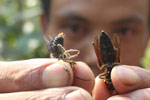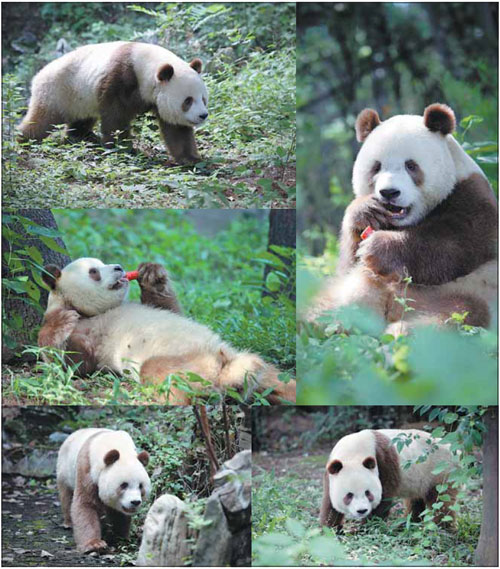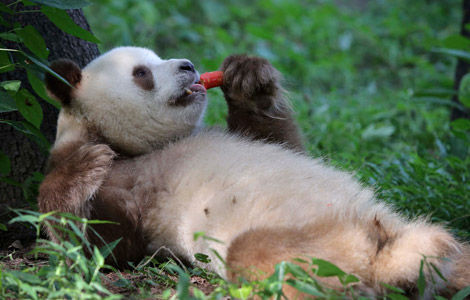Brown is unique
Updated: 2013-10-16 07:07
By Ma Lie (China Daily USA)
|
||||||||
Most giant pandas are black and white. But since 1985, the endangered animals with brown fur have been spotted five times. Scientists tell Ma Lie that further studies are necessary to unravel the mystery of such a rare type.
Some photos of a white-brown panda recently caused a stir among netizens. They were surprised that the rare and cute animal, which usually has a black-and-white coat, has a "colorful" variety.
The white and brown panda named Qi Zai is living in Shaanxi Rare Wildlife Rescue, Breeding and Research Center, located in the Qinling Mountains in Zhouzhi county in Shaanxi province.
The panda was found on Nov 1, 2009 in Shaanxi Foping National Nature Reserve, in Foping county. With a total area of 350 sq km in deep mountains, the reserve is home for many endangered animal species including giant panda, golden monkey and takin.
At noon on that eventful day, Liang Qihui, senior engineer of the reserve and his colleagues found the panda pup just after its mother went into the jungle. The little animal, with clumps of brown fur, was barely 2 months old and weighed about 2 kg, Liang recalls.
To better protect the rare panda type, the baby panda was sent to the center from the reserve.
According to Jin Xuelin, deputy director of the center, the baby panda was weak when it was sent to the center, and recovered later after getting proper medical treatment and taking some panda milk saved by the center staff from other pandas.
The center was established in 1996 focusing on the rescue, breeding and research of rare animals including giant panda, golden monkey and crested ibis, which are mainly found in the Qinling Mountains.
The size, weight and habits of Qi Zai are similar to other pandas, but it is the only captive white-brown panda in the world, Jin says.
Jin stresses the center would not take such a panda for research if it didn't need to be rescued.
"The existence of brown-fur panda is normal and plausible, excessive disturbance by our humans will disrupt its normal reproduction," Jin says.
This was not the first time such colorful pandas have been found. The panda research records show that such white-brown pandas have been documented five times.
A panda named Dan Dan was the first of its kind found on March 28, 1985 in Foping reserve and was sent to Xi'an Zoo in Xi'an, capital of Shaanxi province on May 8, 1985, as there was no proper rescue center then.
The female Dan Dan gave birth three times from 1986 to 1989 and the baby pandas all had white-black coats.
According to Lu Guoyou, a villager in Daguping village in Foping reserve and the first person to see Dan Dan in the wild, he found the panda by accident and noticed that it was very weak because of illness.
Panda expert, professor Pan Wenshi from Peking University, was studying in the reserve then and so Lu reported the sighting to him.
Pan and his students went to the spot where the panda stayed and initially thought the brown color on the panda was dirt and soil. But they realized later that the panda had brown fur. "The panda was so beautiful with a pair of brown eyes and brown lips," Lu says.
The professor and his students treated the ill panda and then sent it to the reserve administrative bureau.
Dan Dan died of cancer on Sept 7, 2000 in the zoo and was made into an animal specimen and placed at the entrance of the herbarium in Foping reserve.
An old hunter living in the reserve areas says that he used to see a brown panda as early as 1954 in the mountains. But some experts did not think the brown panda was an independent population. Some think that the brown fur of the panda likely indicated its ancestry.
Other experts opined that the brown panda might be the result of inbreeding, as the panda population in the Qinling Mountains is small and isolated with an estimated figure of between 200 and 300.
Pan Wenshi raised a possibility that the brown fur of the pandas in the Qinling Mountains might have some links with the area's unique geographical and climatic conditions. The soil and water in the area might influence the hair pigments of the pandas.
Fang Shengguo, animal researcher with Zhejiang University, provided another hypothesis that the brown fur was caused by a kind of recessive gene in the pandas.
The gene for black fur of the pandas is dominant which made most of the pandas white and black, and to have brown fur, the recessive gene of brown fur must be carried by both father and mother pandas.
But the probability of carrying the recessive gene by both father and mother was very small, Fang says.
Liang Qihui supports Fang's hypothesis and considers the brown fur on the pandas as the result of the recessive genes combination.
He says further studies are necessary to have a conclusive answer on the mystery of brown giant pandas.
Based on the discovery of brown-fur pandas and the differences in bone structure between the pandas in the Qinling area and those in Sichuan province, scientists announced in 2005 that pandas in the Qinling Mountains belong to a unique subspecies, which have a relatively small skull and larger molars.
Contact the writer at malie@chinadaily.com.cn.
|
Qi Zai, at Shaanxi Rare Wildlife Rescue, Breeding and Research Center in Zhouzhi county, is the only captive white-brown giant panda in the world. Photos by Wang Lei / for China Daily |
(China Daily USA 10/16/2013 page8)
Most Viewed
Editor's Picks

|

|

|

|

|

|
Today's Top News
IMAX in China exceeds CEO's expectations
China-UK cooperation projects inked
A life devoted to China-US ties
US inches toward deal to reopen govt
Beijing-Tokyo ties 'unlikely to recover soon'
Yao, NBA to open training school for teens
Chinese firm in talks to buy NJ site
Alcoa CEO to be feted by US-China Committee
US Weekly

|

|















